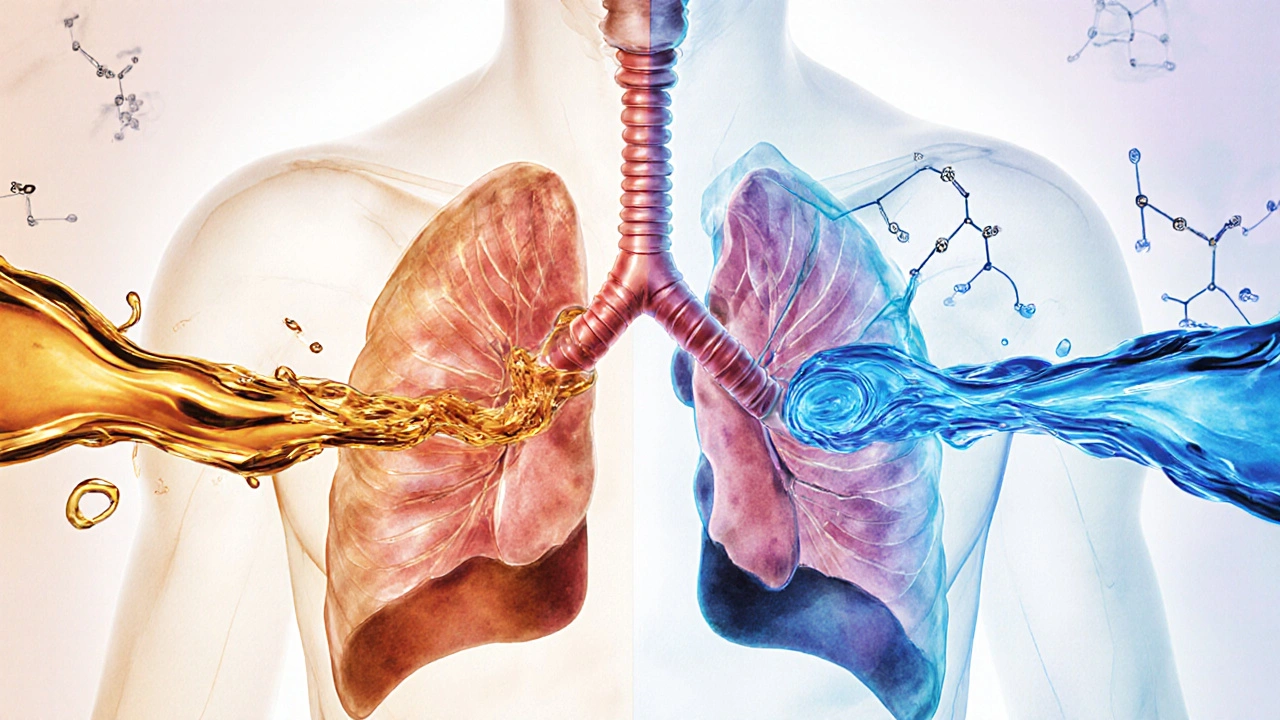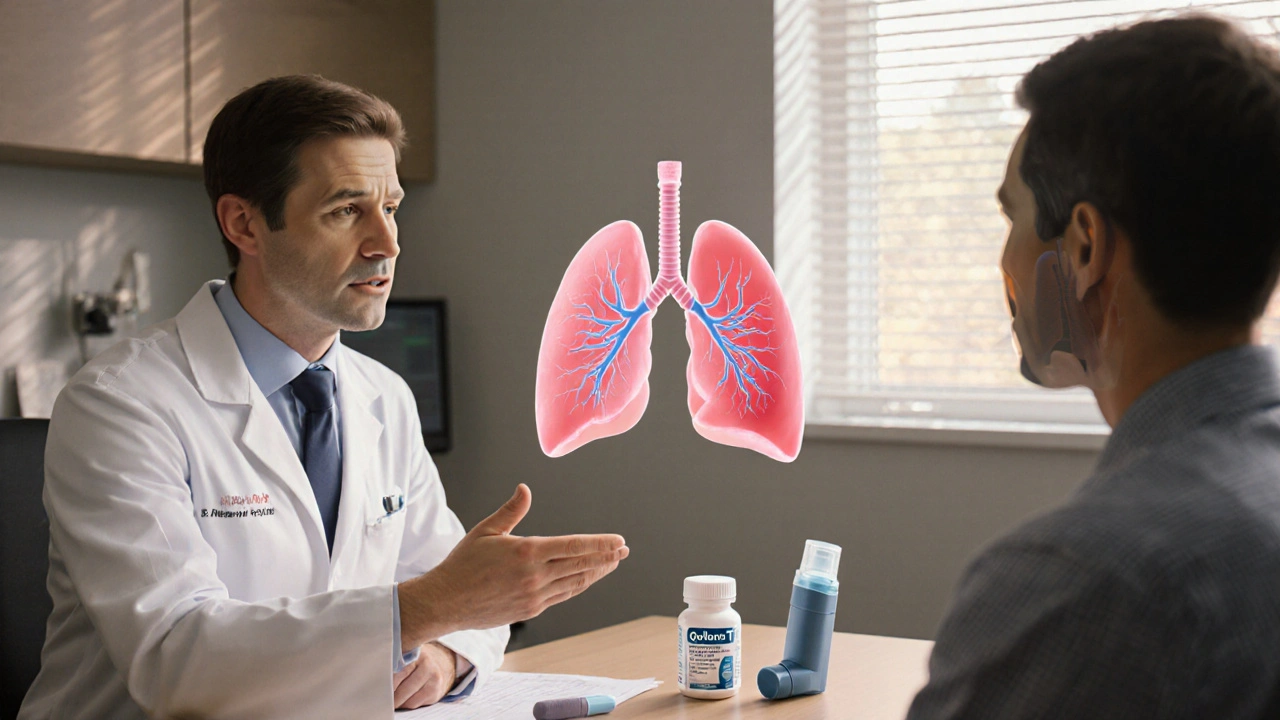Quibron-T vs. Alternatives Comparison Tool
Select your patient's primary condition and preferred treatment approach to see how Quibron-T compares with other medications.
Primary Condition
Preferred Treatment Approach
When doctors treat asthma or COPD, they have a menu of drugs to pick from. Quibron‑T-the brand name for theophylline-still sits on that menu, but many wonder if newer agents offer better relief or fewer hassles. This guide breaks down what Quibron‑T does, how it stacks up against popular alternatives, and which factors should tip the scale toward one drug or another.
What is Quibron‑T (Theophylline)?
Quibron‑T is a tablet formulation of the methylxanthine Theophylline that relaxes airway smooth muscle and improves diaphragmatic contractility. It’s approved for chronic management of asthma and COPD, typically when inhaled therapies alone don’t provide sufficient control.
How Theophylline Works
Theophylline belongs to the methylxanthine class. It works by inhibiting phosphodiesterase, raising intracellular cyclic AMP, and thereby promoting bronchodilation. Additionally, it antagonizes adenosine receptors, which reduces bronchial inflammation. Because its mechanism is systemic, the drug reaches peripheral airways that inhalers might miss.
Common Alternatives in Respiratory Care
Physicians often consider several other bronchodilators before-or alongside-Theophylline. Below are the most frequently prescribed options:
- Albuterol - a short‑acting beta‑agonist (SABA) that rapidly opens airways for acute symptom relief.
- Salmeterol - a long‑acting beta‑agonist (LABA) used twice daily for maintenance control.
- Ipratropium - a short‑acting anticholinergic that blocks muscarinic receptors, reducing bronchoconstriction.
- Montelukast - a leukotriene receptor antagonist (LTRA) that curbs inflammation and is taken orally once daily.
Each of these agents targets a different pathway, offering unique advantages and drawbacks.
Side‑Effect Profiles: What to Expect
Side effects often dictate a drug’s real‑world usability. Theophylline’s narrow therapeutic window can cause nausea, insomnia, tachycardia, and, in severe cases, seizures. In contrast, Albuterol may cause tremor or jittery feelings, while Salmeterol carries a rare risk of asthma‑related death when used without an inhaled corticosteroid. Ipratropium’s most common complaint is a dry mouth, and Montelukast is associated with neuropsychiatric symptoms in a minority of patients.
Therapeutic Drug Monitoring (TDM)
Because Theophylline levels must stay between 10-20µg/mL for efficacy without toxicity, clinicians order regular blood draws. This monitoring adds cost and inconvenience. The other agents listed above generally do not require TDM, which explains why many practices favor them for routine management.

Comparison Table: Quibron‑T vs. Alternatives
| Drug | Class | Onset (minutes) | Duration (hours) | Typical Use | Monitoring Needed | Common Side‑Effects |
|---|---|---|---|---|---|---|
| Quibron‑T | Methylxanthine | 30-60 | 6-12 | Adjunct therapy for chronic COPD / asthma | Blood level | Nausea, insomnia, tachycardia |
| Albuterol | SABA | 5-15 | 4-6 | Acute relief | None | Tremor, palpitations |
| Salmeterol | LABA | 15-30 | 12 | Maintenance | None (except in rare combos) | Hoarseness, rare asthma‑related death |
| Ipratropium | Anticholinergic | 15-30 | 4-6 | Bronchospasm relief, especially COPD | None | Dry mouth, cough |
| Montelukast | LTRA | 60-90 | 24 | Adjunct for allergic asthma, exercise‑induced bronchoconstriction | None | Headache, mood changes |
Decision Factors: When to Choose Theophylline
Even with its quirks, Theophylline shines in specific scenarios:
- Resource‑limited settings: Oral tablets don’t require inhaler technique training, useful where devices are scarce.
- Peripheral airway disease: Systemic delivery reaches lung regions that inhaled β‑agonists can miss.
- Combination therapy: Adding Theophylline to inhaled steroids can reduce exacerbation frequency in severe COPD, as shown in GOLD (Global Initiative for Chronic Obstructive Lung Disease) studies.
If any of the above align with a patient’s profile, the benefits may outweigh monitoring burdens.
Practical Tips for Prescribing Quibron‑T
- Start at a low dose (e.g., 200mg twice daily) and titrate based on serum levels.
- Check baseline liver and kidney function; impaired clearance raises toxicity risk.
- Educate patients to avoid caffeine and certain antibiotics (e.g., macrolides) that can boost Theophylline levels.
- Schedule follow‑up labs after 5‑7 days of dose changes, then quarterly if stable.
These steps keep the drug’s narrow therapeutic index in check while preserving its bronchodilatory edge.
Related Concepts and Wider Context
Understanding Quibron‑T’s place in therapy involves a handful of broader ideas:
- Bronchodilator - any medication that relaxes airway smooth muscle; includes β‑agonists, anticholinergics, and methylxanthines.
- COPD - a progressive lung disease where airflow limitation is not fully reversible; treatment often combines inhaled bronchodilators with systemic agents like Theophylline.
- Asthma - a reversible airway inflammation condition; Theophylline is now a third‑line option after inhaled steroids and β‑agonists.
- GOLD Guidelines - the leading worldwide consensus for COPD management; they list Theophylline as an optional add‑on for selected patients.
- American Thoracic Society (ATS) - a professional body that reviews evidence on bronchodilator efficacy and safety.
Exploring these concepts deepens the rationale behind each drug choice and helps clinicians personalize therapy.
Bottom Line: Picking the Right Tool
If a patient can handle regular blood draws, avoids caffeine, and needs extra peripheral airway coverage, Quibron‑T stays a viable contender. For most people, however, inhaled SABAs, LABAs, or LTRAs offer quicker relief with fewer monitoring headaches. The key is matching drug characteristics-onset, duration, side‑effect burden, and monitoring requirements-to the individual’s lifestyle and disease severity.
Frequently Asked Questions
What conditions is Quibron‑T approved to treat?
Quibron‑T is FDA‑approved for chronic management of asthma and chronic obstructive pulmonary disease (COPD) when other inhaled therapies are insufficient.
How does Theophylline differ from beta‑agonists like Albuterol?
Theophylline works systemically by inhibiting phosphodiesterase and blocking adenosine receptors, leading to smooth‑muscle relaxation. Albuterol, a beta‑agonist, activates β2‑adrenergic receptors on airway smooth muscle for rapid, short‑term bronchodilation.
Do I need regular blood tests while on Quibron‑T?
Yes. Therapeutic drug monitoring is essential because the therapeutic window is narrow (10‑20µg/mL). Levels are typically checked 5‑7 days after any dose change and then every 3‑6 months if stable.
Can Theophylline be taken with caffeine?
Caffeine can increase serum Theophylline concentrations and raise the risk of side‑effects. Patients are usually advised to limit or avoid coffee, tea, and energy drinks while on the drug.
What are the most common side‑effects of Quibron‑T?
Nausea, insomnia, headache, and tachycardia are the top complaints. In rare cases, high levels can cause seizures or cardiac arrhythmias.
Is Theophylline still recommended in the latest GOLD COPD guidelines?
GOLD lists Theophylline as an optional add‑on for patients who remain symptomatic despite optimal inhaled therapy, especially when cost or inhaler technique is a barrier.
How does Montelukast compare to Theophylline for asthma control?
Montelukast targets leukotriene‑mediated inflammation and is taken once daily, making adherence easier. It lacks bronchodilatory strength, so it’s usually paired with an inhaled corticosteroid, whereas Theophylline provides direct airway relaxation but needs monitoring.


inder kahlon
Theophylline remains a viable adjunct when inhaled therapy falls short. Its systemic action reaches peripheral airways, and the drug’s oral formulation simplifies dosing in settings lacking inhaler devices. However, the narrow therapeutic window necessitates regular serum level checks, typically 5‑7 days after any dose adjustment, then every 3‑6 months if stable. Patients should also avoid caffeine and certain antibiotics that inhibit metabolism. Dose titration starts low, often 200 mg twice daily, and is guided by the target concentration of 10‑20 µg/mL.
Dheeraj Mehta
Thanks for clarifying! 😊 The monitoring part always feels like a hassle, but it’s good to know why it matters.
Oliver Behr
In the UK we’ve seen a shift toward LABA/ICS combos for most asthma patients, relegating theophylline to a niche role.
Kyle Salisbury
True, but for patients with limited access to inhalers, a cheap oral tablet can still make a difference.
Angie Robinson
Honestly, theophylline is a relic. Its side‑effect profile-nausea, insomnia, tachycardia-outweighs any marginal benefit, especially when modern inhalers are affordable.
Emmons Kimery
I get where you’re coming from, but some severe COPD cases still need that extra bronchodilation, and theophylline can reduce exacerbations when other meds fail.
Mimi Saki
It’s all about matching the drug to the patient’s lifestyle; an oral pill might be the only thing they’ll actually take consistently.
Subramaniam Sankaranarayanan
People love to market new bronchodilators as miracles, yet they ignore the physiological reality that systemic agents like theophylline can access distal airway smooth muscle inaccessible to aerosolized particles. Moreover, the drug’s pharmacokinetics are influenced by liver and kidney function, making dosing in the elderly especially tricky. If you consider drug‑drug interactions, macrolide antibiotics and fluoroquinolones can raise serum levels dramatically, leading to toxicity. So, while theophylline’s reputation is tarnished, dismissing it outright is scientifically lazy.